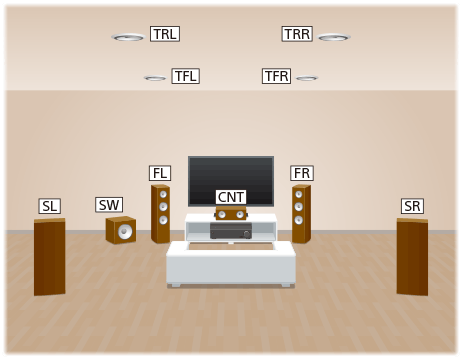

The black Arc that I’ve been using looks fantastic beneath my TV. The clean, perforated design - Sonos drilled 76,000 holes into the thing - refocuses your attention on style instead of materials. The outer shell is all matte-finish plastic, but nothing about it feels cheap. The Arc can be mounted to the wall, and when in this orientation, it automatically adjusts frequencies and reduces bass resonance to avoid rattling your living room. If you’re dealing with tight quarters in a small apartment, the Beam is far easier to fit in.
Dolby 5.1 speakers tv#
At 45 inches long (a 10-inch increase over the Playbar), it takes up nearly the entire width of my TV stand and is almost as wide as the 55-inch TV I’ve been using it with. The Arc is a very wide soundbar that’s clearly meant to be paired with large TVs. Sonos includes an HDMI-to-optical adapter in the box, but you lose out on Atmos altogether if you use optical audio, so I really don’t know why anyone would bother. eARC also synchronizes the audio and video signals automatically - eliminating the slight lip-sync issues I’ve sometimes encountered when sending surround sound signals to the Beam and a Vizio soundbar that I also own. And the very newest models from LG, Sony, and others have an updated version of HDMI ARC called eARC ( enhanced audio return channel), which offers more bandwidth, faster data transfer, and supports lossless Atmos from Blu-ray players. That said, most recent 4K TVs should be capable of sending Atmos audio from apps like Netflix to the soundbar through the TV’s HDMI ARC port. This was a limitation in our testing: the 2016 LG B6 OLED in Nilay’s media room can’t send Atmos out through its HDMI port, and Sonos sent him a newer Sony TV so he could test Atmos on the Arc. If you have a TV from before 2017 or so, it may not be able to send Atmos out through HDMI, and you can’t plug an Atmos device like an Apple TV into the Sonos directly. Sonos made a key design choice to only put a single HDMI port on the Arc, meaning you’ll need a TV that can send Atmos out through its HDMI ARC port in order to hear the fullest possible surround sound. However, it’s important to note right at the top that to get the most out of the Arc, you’re going to need a TV purchased within the last couple years.

Dolby 5.1 speakers how to#
It’s a reminder that even as Sonos ventures into services, voice AI, and evolving its platform, it still knows how to make damn fine speakers. Hearing the Arc will make you want to own it. 4K TVs are everywhere, but many people might be more reluctant to invest in sound beyond your token $200 Vizio soundbar. I suspect it will also be the introduction for many people to Dolby Atmos audio in the home.
Dolby 5.1 speakers upgrade#
Whereas the $399 Beam was aimed squarely at the massive market of people looking to upgrade the dull, lackluster sound coming from their TV speakers, the $799 Arc represents the pinnacle of what Sonos can do in the living room. The new Sonos Arc soundbar is perhaps the biggest flex of the company’s design, engineering, and technology advancements that we’ve seen yet.


 0 kommentar(er)
0 kommentar(er)
